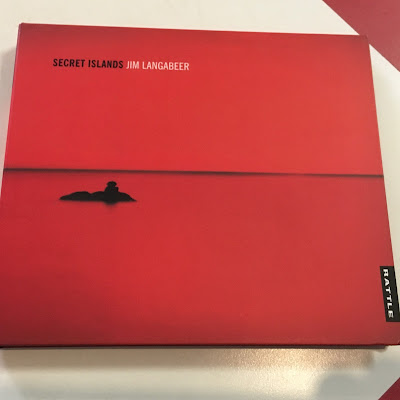Okay, so I'm running a little late.... maybe not the best start for 2018 but here it is.
The
pattern of alternating between newer and older releases continued in
December with Jim Langabeer's Secret Islands,
released in mid-2017.
All 11
pieces are by Langabeer. They stand alone really well and combine
make a great album with a lot of variety yet there is a unified
thread running through the work making for a superb album. The choice
of personnel is crucial and Langabeer made great choices and the
instrumentation provides plenty of textural/color variety too.
Jim Langabeer (tenor sax/flute/alto flute/putorino) Roger Manins (alto sax) Rosie Langabeer (piano/fender rhodes, organ) Neil Watson (guitar/pedal steel) Eamon Edmundson-Welles (b) Chris O'Connor (d)
Rosie
was one of the more creative musicians during my time at music school
but I haven't heard too over the past several years so her inclusion
is a welcome one for me. Roger is the foil to Langabeer's stripped
bare approach – reminded me a bit of the contrast between Miles and
his saxophonists. It's nice to hear him on alto too.
When he
was based in Wellington I regularly heard Chris O'Connor and he's one
of my favourite drummers on the NZ scene. His versatile and creative
playing is somewhat understated here but integral to the overall
sound of the album.
Neil
Watson was in some ways the surprise package (most likely due to me
not really keeping tabs on his work). He combining
jazz/rock/blues/country to great affect. His pedal steel playing is
an important part of the sonic make-up of the album.
Eamon
Edmundson-Welles was the only player I wasn't familiar with. He slots in
really well. Nice arco tone. Sometimes the bass is a little muddied
in the mix but when it's not it pops. He hooks up well with Chris.
I never really heard much of Jim's music but I was aware of his position as a veteran of the New Zealand jazz scene. His recordings
are few and far between - the Superbrew album is on the shelf waiting
for a spin but I'm not aware of others (suggestions and
recommendations welcome!).
His playing is unhurried,
sparse and the importance of tone as an expressive device comes through. It's not ego driven, leader centric music. He's not dominating in any way as an
individual (and often takes a backseat to proceedings) but still his conception comes through clearly.
“Bad Call” eases the listener in and is nice introduction for the
things to come. The piece simmers as the collective improvisation
builds.
The lounge-y “Rata Flowers” features a dreamy padding of pedal
steel and mellow fender rhodes with melodic tenor floating above.
The
melody of “What If” features multiphonics from the saxophones
over a slinky swing feel. Rosie digs into the blues with unexpected
twists and turns. Her rhythmic strength holds things together. Watson
opens with staccato playing before moving onto the slide with plenty
of off-kilter blues swagger (much like Rosie but with different
outcomes). And Roger gets slippery on alto before the out head. For
whatever reason I couldn't help but think of film noir and Neil
Young's Tonight's the Night.
The collective improvisation, shifting tempos and hits of “The Big
Smoke” keeps your ears primed for surprises. Provides a nice
example of contrast between the saxes – Roger follows Jim's lead
but with busier approach. Roger may be a more slick or conventionally virtuosic, but he is not lacking in fire or feeling.
“Tangi” is well placed following the more hectic “Big Smoke.”
No one overstates their case and it's a wonderfully paced piece. The
droning guitar and arco bass lay the foundation. The two saxes have a
cry to their tone (with Roger drawing on some influences from India).
One of the highlights of the album is the Rosie's solo piano stretch
that ends the piece.
“Out Of Harm's Way” gives Chris some room to solo with backing
from the rest of the band. There'a nice angular and jagged dialogue
between bass and piano and plenty of exuberant saxophonic wailing as
Jim and Roger ride tandem on the way home.
The Unhurried and well placed “Hinemoa and Tutanekai” makes great
use of minimalism. Featuring the saxes playing octaves, multiphonics,
and sustained notes. There's very subtle background tinkling (what is
that... organ/guitar/bass? - great texture) with percussion
eventually added to the mix. Space is a key ingredient.
Alto
sax, flute, and piano improvisations are underpinned with textural
drums and sparse bass lines until an explosion of distorted guitar
really starts ramping things up for just a moment on “Orakei
Karoako.” “Freequency” flows in from the previous piece with dense
distorted guitar and rolling percussion.
Again there's some Indian allusions on “Central Plateau” with lyrical flute, drone-ish
guitar and mallet percussion opening the piece. It kicks into some
solid swing for Rog and Watson to blow over. Rosie's comping behind
the alto solo grabbed my ear. Things settle as the flute re-enters
but the piece doesn't lose urgency.
“Waiata o te Taniwha,” a lullaby-like tenor feature, seems like the
perfect way to sign off.
Secret Islands made great listening during December and feel it is an album I will keep
returning to. For me, the two key ingredients are fun and mystery.
Highly recommended.
Final
words.... more Jim Langabeer please!

No comments:
Post a Comment